Small Space, Big Backstories
Aaron Anderson creates highly individualized portraits of an artists' collective in a confined space with the Tamron SP 15-30mm VC G2 lens.
More Photo Tips | Video Gallery | Photo Gallery | Enewsletter sign-up
By Jenn Gidman
Images by Aaron Anderson
When the SPQR artists' collective decided to pitch an exhibit for Meow Wolf, an immersive art installation out of New Mexico, the group recruited Colorado photographer Aaron Anderson to do a photo shoot for them. "They wanted to showcase themselves, both individually and as a group," he says. "And so we undertook this collaboration where I would tell each of the artist's stories through a portrait. We sat down together for four hours, talking about each artist, what their background was, and how they worked. My goal was to balance each portrait so that there was something meaningful in each photo—something only the artist and those close to them would understand—but so an outsider would still think it was a beautiful image."
Aaron had intentions of tapping into a variety of lenses for this session, which was shot entirely with studio lighting, but the space they were photographing in was so small that he opted for the Tamron SP 15-30mm F/2.8 VC G2 wide-angle lens for the entire shoot. "If you watch the behind-the-scenes video, you'll see that every picture was taken pretty much in the same room; we just redid the set to customize it for each artist so every portrait looked different," he explains. "So I was in a very confined space—sometimes only 6 to 8 feet away from my subject—but I had to get the entire room into the frame and make it appear as a large, open space. I couldn't have done that without the 15-30 lens. I also love using this lens for portraits, which isn't why I originally bought it. It adds a somewhat unconventional look to my portraits."
Read on for the backstory on each artist and how Aaron conceptualized their accompanying portraits.
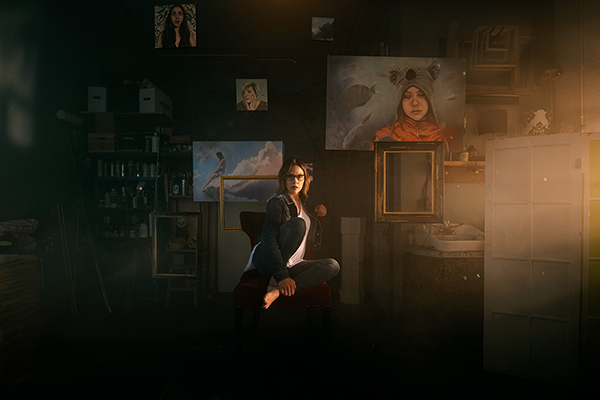
15-30mm @ 15mm, f/2.8 1/200 at ISO 100
Click image to view larger
April had taken a sabbatical from art to spend time with her children, and she's only recently returned. Many of the paintings hanging behind her are portraits of her kids. The empty frames you see in the image go along with the idea that she's on a new journey and encountering new experiences, entering an unexplored world and a new era in her life.
We had two lights out the window and one large umbrella over the top of the subject to provide some fill. We also had one 7” reflector camera left with a cyan gel, pointed to the wall to offer a moodier feel. I'm standing in a doorway, and right behind me is a giant Octabox on low power to provide a little fill in the entire space. What I usually do to create "outside" lighting is stack two heads outside with reflectors on them, as well as add CTO or orange gel on them to create this terrific hard light that looks like the sun. I'll often shoot it through the window, because the window offers some really interesting diffusion qualities to it. Most people notice that my images have a hazy quality to them, and one of the most common questions I get is if I use a hazer, the answer is most definitely yes. It’s not only for the mood of the image, but it also enables you to see the lighting coming through windows and creates it’s own modifier.
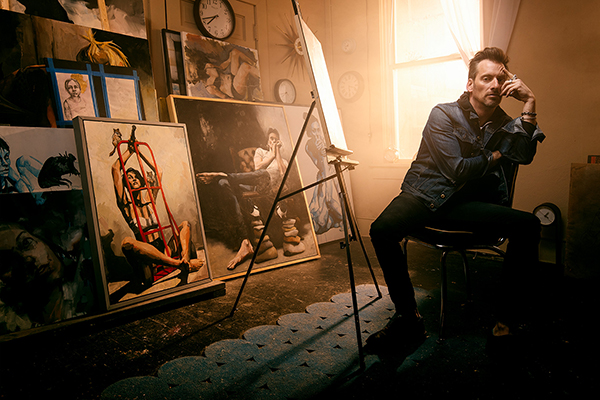
15-30mm @ 26mm, f/8 1/250 at ISO 100
Click image to view larger
Brett is the head of SPQR, and he was recently diagnosed with a rare form of leukemia that doesn't have any cure. You'll notice in the image there are clocks all over the place, which we added into the scene to signify that he has limited time. All of the artwork in the photo is his work, plus we put a blank canvas next to him as if he's about to create a new piece. Using that Tamron 15-30 lens here was an absolute necessity: I was crammed on the floor up against the door, there's no way I could've achieved that shot without it.
There were two lights shooting through the window camera left—one on top, one on the bottom—with orange gels on them. Then, just out of frame to camera right there's another window, and that window has two heads inside an umbrella just to offer a bit of glow. We had a big boom arm straight above Brett with a gridded softbox to control the light pointed at him. Then we had another four heads pointed into the large white wall right behind me to fill the entire scene. It basically turned the wall into a giant softbox.
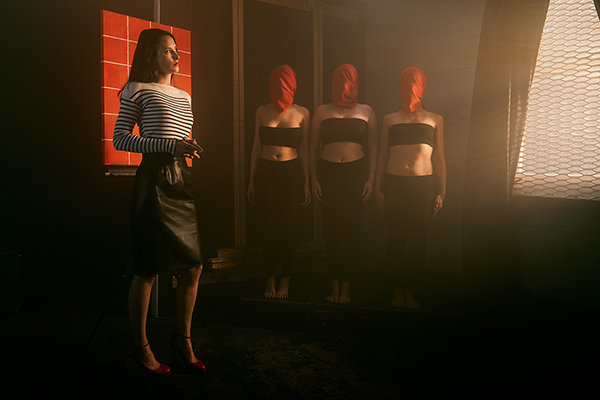
15-30mm @ 24mm, f/5.6 1/250 at ISO 64
Click image to view larger
Claire's particular style is that she places people in her paintings that have their faces covered with cloth. We thought it would be interesting to embody that and bring those people into the photo with her. Claire is also incredibly poised, almost with a European vibe to her—she doesn't have crummy clothes she paints in, so it felt natural to put her in a pencil skirt and pumps for this image. She also always grids all of her canvases, because she's super-organized, so we wanted to incorporate that into the image as well. We had two lights coming through the window for this photo, with large gridded softbox over the three models, and a large Octabox coming in from the left that lit Claire, feathering off to light her canvas just a tad.
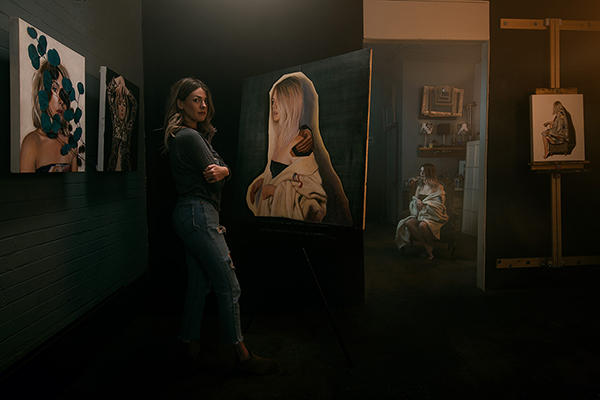
15-30mm @ 20mm, f/8.0 1/250 at ISO 64
Click image to view larger
Selby only paints self-portraits. In fact, we have her in this image twice—where she's shown sitting in the chair in the background, we actually had her mirror what she was wearing in one of the paintings up front. It's funny, though, because Selby is a very humble person and feels somewhat self-conscious about putting paintings of herself out there; it makes her feel vulnerable. It's a hard thing to put yourself out there like that, because it's not only your art, but it's yourself, as a person, that you're showing the world.
In this image we used quite a bit of lighting, but most of it was to provide subtle fill to the room. In the foreground we have a small gridded soft box over her with a 53” octa camera right to add a “window”. I also have a 75” octa pushed back to fill the space. In the background we are lighting her with a large strip and have the two heads outside on a lower power with CTO. Obviously this is a composite and it's lit in pieces. We had Selby sit in the chair to get the background shot, then I had her change her clothes and stand in front of her painting for the foreground. Then I merged those images during post-processing.
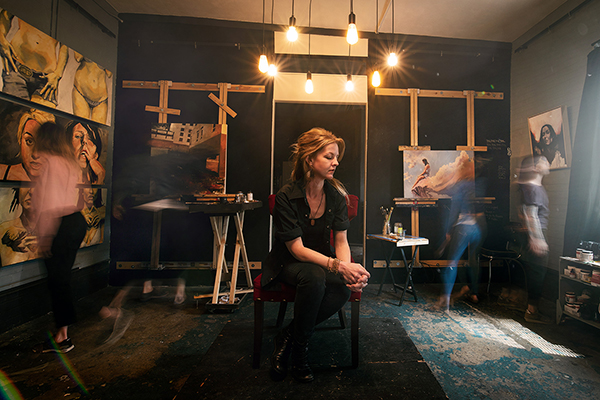
15-30mm @ 15mm, f/7.1, 1 sec exposure at ISO 64
Click image to view larger
Kelly isn't an artist in the same sense as the others—she's a musician. Her job within the group is to compose music that compliments and helps the mood in the room for upcoming shows. When they put together installations, they'll often include music pieces side by side with the artwork, and Kelly will help write that. So the idea here for this photo was that the movement and flow of the artists is the space in which she creates. That visual reference of their movements is what she's simulating in her music, and how they all come together as a team. This was a long-exposure shot where we used modeling lights, which you typically just use to focus, and those lights are lighting the subjects. It's a two-second exposure, and once the camera is about to close the lens, it fires the strobes and freezes the main subject. We used a gridded soft box over her to mimic the light you see in the frame, the grid is used to keep the light from spilling onto the other subjects so they stay blurred.
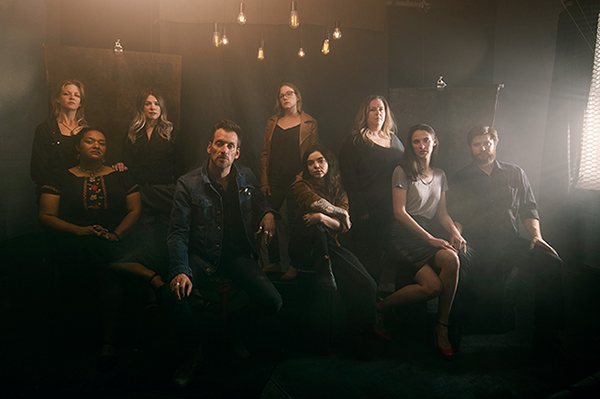
15-30mm @ 23mm, f/9 1/250 at ISO 64
Click image to view larger
Simply put, this is a group shot, with no really crazy meaning behind it. We put Brett in the middle, obviously, as he's the collective's leader. The one-light technique for this image is similar to what Annie Liebovitz and many other photographers employ. We had two large umbrellas overhead and two heads out the window, then we used a 53-inch Octabox to light each subject individually. With this technique you’ll need your camera on a tripod, then you go person by person and get the light nice and close with a heavy feather—or, in this case, maybe three people at a time—and light all the way across the scene. Then I piece all of those separate takes together in Photoshop. It offers a moody type of lighting that feels impossible, because it more or less is impossible, unless you do it the way I just described. I wanted this photo to make them feel as cool as the rest of the world thinks they are, empowered and on their journeys.
To see more of Aaron Anderson's work, go to https://andersonvisuals.com. Check out a behind-the-scenes video of Aaron's shoot with the SPQR artists' collective here.
More Photo Tips | Watch Videos | Learn More About Tamron Lenses | Photo Gallery
